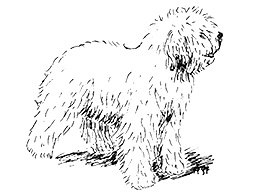Polish Lowland Sheepdog Breed Standard
Last updated: 22 Feb 2017
A breed standard is the guideline which describes the ideal characteristics, temperament, and appearance of a breed and ensures that the breed is fit for function with soundness essential. Breeders and judges should at all times be mindful of features which could be detrimental in any way to the health, welfare or soundness of this breed.

Kennel Club, London 1994
-
Group:
Group 5 (Working Dogs)
-
History:
-
General Appearance:
Medium size, cobby, strong, muscular, fairly long thick coat.
-
Characteristics:
Lively but self-controlled, watchful, bright, clever, perceptive with excellent memory. Easy to train, works as a herding and watch dog.
-
Temperament:
-
Head And Skull:
Medium size, proportionate to body, not too heavy, carried moderately low. Profuse hair on forehead, cheeks and chin make head appear larger than it is. Proportions of occiput to stop and stop to nose approximately equal, but muzzle may be fractionally shorter. Skull moderately broad, slightly domed, furrow from stop to occiput apparent when handled. Well defined stop. Nose blunt, wide opened nostrils, colour dark as possible.
-
Eyes:
Medium size, lively penetrating gaze, oval shaped. Colour hazel to brown. Eye rims as dark as possible, closely fitting and showing no haw.
-
Ears:
Medium size, heart-shaped, large at base and set moderately high, drooping with fore edge close to cheeks.
-
Mouth:
Jaws strong with a perfect, regular and complete scissor bite, i.e. the upper teeth closing overlapping the lower teeth and set square to the jaws. Strong and evenly placed teeth. Lips tightly closed and as dark as possible.
-
Neck:
Strong, muscular, medium length without dewlap.
-
Forequarters:
Shoulders well placed with good lay-back, muscular. Legs when viewed from front or side, straight with slightly slanting pastern.
-
Body:
Rectangular rather than square when viewed from side. Deep brisket with moderate spring of rib, neither flat nor barrel shaped. Withers distinctly marked; back level, muscular, with broad loin. Belly slightly drawn up. Croup short and slightly sloping. Proportions-Height to length as 9:10.
-
Hindquarters:
Well angulated, with broad and well muscled thigh. From behind, legs straight, turning neither in nor out. Hocks strong and distinctly angled.
-
Feet:
Oval, slightly arched but tight fitting toes, with hard pad, nails dark.
-
Tail:
Docked: Customarily docked if not born tailless or stumpy.
Undocked: Any length acceptable, longer tails well covered with hair. Tail set is a continuation of croup. Carried high and slightly curved over back when alert. Never curled over back. At rest, tail hangs low.
-
Gait/Movement:
Smooth walking or trotting. Inclined to amble.
-
Coat:
Whole body covered with long dense, shaggy thick coat of harsh texture with soft undercoat, but never impeding the dog’s movement/action. Long/profuse hair on head, falling forward over the eyes in a characteristic manner, but not impeding the dog’s vision. Slight wave permissible. No loose skin anywhere on body. No evidence of coat trimming to enhance or change the natural outline of the dog.
-
Colour:
All colours other than merle acceptable.
-
Sizes:
Height:
Dogs 45-50 cms (17 3/4 - 19 3/4 ins)
Bitches 42-47 cms (16 1/2 - 18 1/2 ins)
-
Faults:
Any departure from the foregoing points should be considered a fault and the seriousness with which the fault should be regarded should be in exact proportion to its degree and its effect upon the health and welfare of the dog.
-
Notes:
Male animals should have two apparently normal testicles fully descended into the scrotum.
 For owners
For owners
 Members
Members
 Dogs Australia is a not-for-profit organisation advocating for the preservation of purebred dogs through ethical breeding.
It champions the highest standard of animal welfare through education and fostering dog-loving communities.
Internationally recognised and established in 1958 as the Australian National Kennel Council (ANKC),
the organisation promotes responsible dog ownership; maintains the ORCHID* heritable canine diseases database;
funds research into canine diseases; and supports state and territory-based member bodies.
Dogs Australia promotes breed conformation shows and community sports for dogs that fulfil a breed’s natural instincts.
Dogs Australia is a not-for-profit organisation advocating for the preservation of purebred dogs through ethical breeding.
It champions the highest standard of animal welfare through education and fostering dog-loving communities.
Internationally recognised and established in 1958 as the Australian National Kennel Council (ANKC),
the organisation promotes responsible dog ownership; maintains the ORCHID* heritable canine diseases database;
funds research into canine diseases; and supports state and territory-based member bodies.
Dogs Australia promotes breed conformation shows and community sports for dogs that fulfil a breed’s natural instincts.







